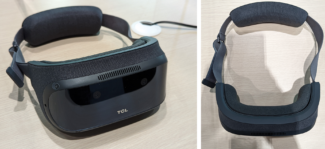At Display Week 2022 TCL presented the most compact LCD panel for VR we’ve seen yet.
 The primary driver of the size and bulk of today’s VR headsets is the display-optics assembly – both the size of the display and the lenses used to magnify it over a relatively wide field of view. Valve’s Index uses 3.5 inch panels, while HP’s slightly more compact Reverb G2 uses 2.89 inch panels. HTC’s Vive Flow, the most compact headset available in the west, uses 2.1 inch displays.
The primary driver of the size and bulk of today’s VR headsets is the display-optics assembly – both the size of the display and the lenses used to magnify it over a relatively wide field of view. Valve’s Index uses 3.5 inch panels, while HP’s slightly more compact Reverb G2 uses 2.89 inch panels. HTC’s Vive Flow, the most compact headset available in the west, uses 2.1 inch displays.
TCL presented two new LCD panels at Display Week. Both have a refresh rate of 120 Hz.
The first is also 2.1 inches, like Vive Flow’s, but whereas Flow’s displays are 1600×1600 TCL’s new display is 2280×2280 thanks to having a density of 1512 pixels per inch. Flow reaches only 75 Hz, but it’s unclear whether this is a limitation of the panels or just a product design decision. This new panel was shown integrated into a fully standalone prototype headset to demonstrate just how compact a standalone with Flow-sized displays could be:
The second has slightly lower resolution, 2160×2160, but is smaller than any VR LCD we’ve seen to date at just 1.77 inches. To achieve this it actually has an even higher density, 1764 pixels per inch. Of course, there are even smaller OLED microdisplays available, but those tend to be significantly more expensive.
Neither new TCL panel is higher resolution or more dense than the stunning 3K panel JDI and Innolux also presented at Display Week. But both TCL panels are smaller, so could theoretically be used in extremely compact headsets.








